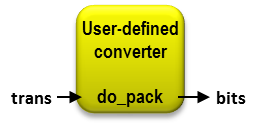UVMC Converter Example - SC Converter Class
This example demonstrates how to define an external converter class for a given transaction type. The user-defined converter class is a template specialization of the default converter, uvmc_converter<T>.

Because most SC transactions do not implement the pack and unpack member functions required by the default converter, a template specialization of uvmc_converter<T> is usually required.
You can define a template specialization for your transaction as in this example, or you could use one of the UVMC_UTILS macros to generate a definition for you. See UVMC Converter Example - SC Converter Class, Macro-Generated for details.
| UVMC Converter Example - SC Converter Class | |
| This example demonstrates how to define an external converter class for a given transaction type. | |
| User Library | This section defines a “user library” consisting of a packet transaction class and a generic consumer model. |
| Conversion code | This section defines a converter specialization for our ‘packet’ transaction type. |
| Testbench code | This section defines our testbench environment. |
User Library
This section defines a “user library” consisting of a packet transaction class and a generic consumer model. This example will define a converter for this packet, then connect an instance of the consumer with an SV-side producer using a blocking transport interface conveying that transaction.
namespace user_lib {
class packet_base
{
public:
enum cmd_t { WRITE=0, READ, NOOP };
cmd_t cmd;
unsigned int addr;
vector<unsigned char> data;
};
class packet : public packet_base
{
public:
int extra_int;
};
// a generic target with a TLM2 b_transport export
#include "consumer.cpp"
}Conversion code
This section defines a converter specialization for our ‘packet’ transaction type.
We can not use the default converter because it delegates to pack and unpack methods of the transaction, which our packet class doesn’t have. So, we define a converter template specialization for our packet type. You would implement a transaction converter for your specific transaction type in much the same manner.
The definition of a SC-side converter specialization is so regular that a set of convenient macros have been developed to produce a converter class definition for you. See UVMC Converter Example - SC Converter Class, Macro-Generated for for an example of using the UVMC_UTILS macros. See UVMC_PRINT for how to define operator<<(ostream&) so you can print your transaction contents to cout or any other output stream.
#include "uvmc.h"
using namespace uvmc;
using namespace user_lib;
template <>
struct uvmc_converter<packet_base> {
static void do_pack(const packet_base &t, uvmc_packer &packer) {
packer << t.cmd << t.addr << t.data;
}
static void do_unpack(packet_base &t, uvmc_packer &packer) {
packer >> t.cmd >> t.addr >> t.data;
}
};
template <>
struct uvmc_converter<packet> {
static void do_pack(const packet &t, uvmc_packer &packer) {
uvmc_converter<packet_base>::do_pack(t,packer);
packer << t.extra_int;
}
static void do_unpack(packet &t, uvmc_packer &packer) {
uvmc_converter<packet_base>::do_unpack(t,packer);
packer >> t.extra_int;
}
};
UVMC_PRINT_3(packet_base,cmd,addr,data)
UVMC_PRINT_EXT_1(packet,packet_base,extra_int)Testbench code
This section defines our testbench environment. In the top-level module, we instantiate the generic consumer model. We also register the consumer’s ‘in’ export to have a UVMC connection with a lookup string ‘stimulus’. The SV-side will register its producer’s ‘out’ port with the same ‘stimulus’ lookup string. UVMC will match these two strings to complete the cross- language connection, i.e. the SV producer’s out port will be bound to the SC consumer’s in export.
class sc_env : public sc_module
{
public:
consumer<packet> cons;
sc_env(sc_module_name nm) : cons("cons") {
uvmc_connect(cons.in,"stimulus");
}
};
// Define sc_main, the vendor-independent means of starting a
// SystemC simulation.
int sc_main(int argc, char* argv[])
{
sc_env env("env");
sc_start();
return 0;
}